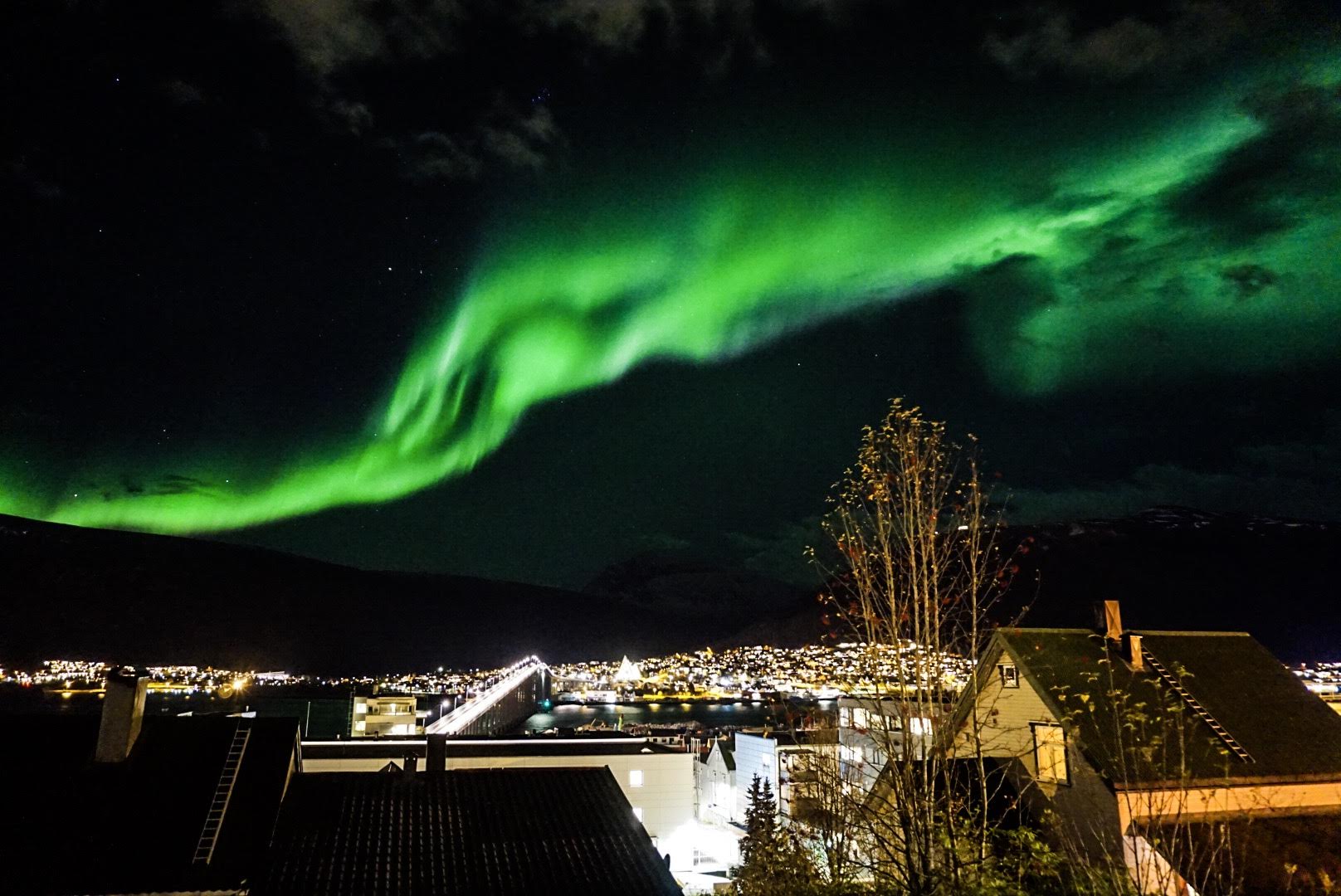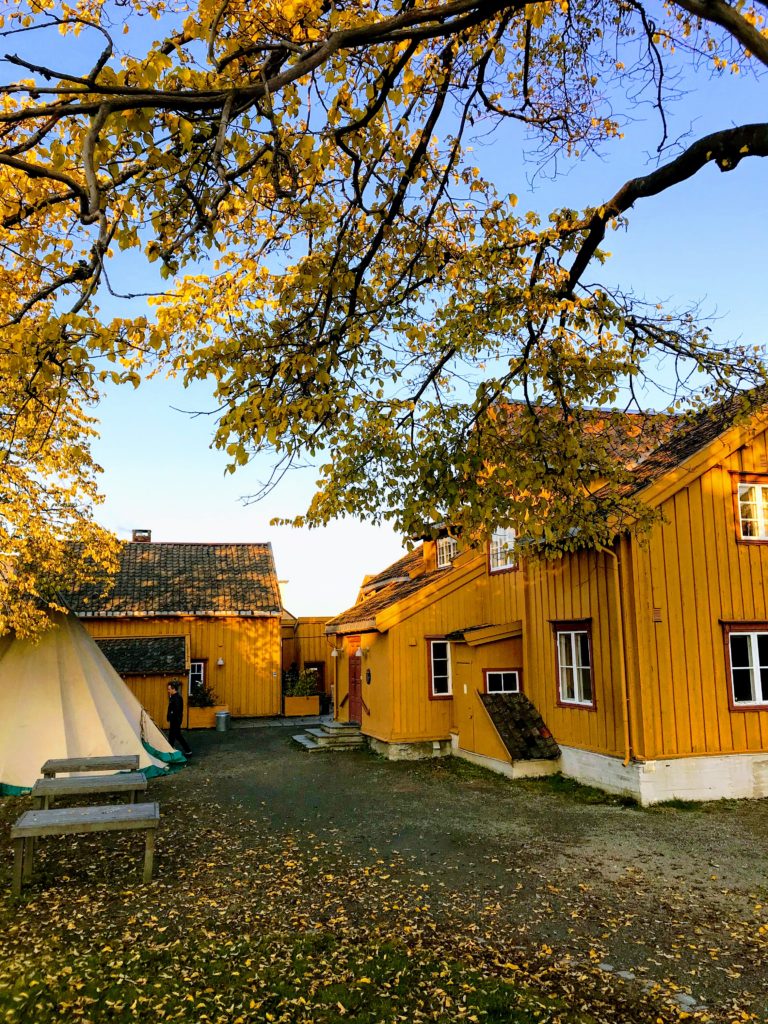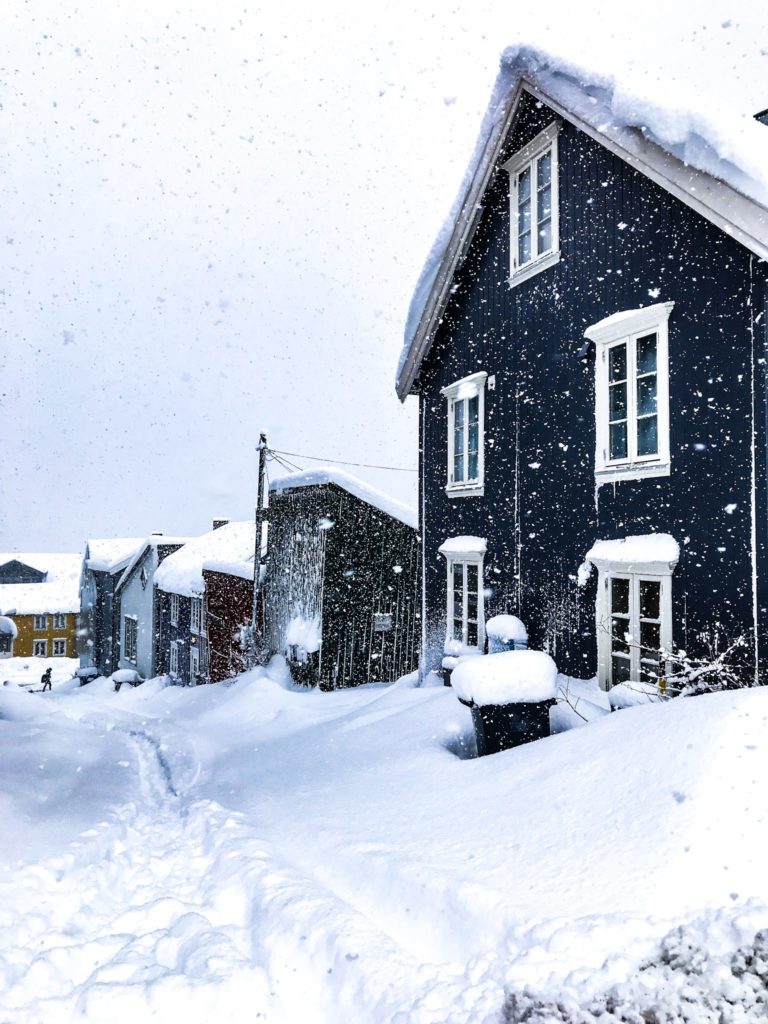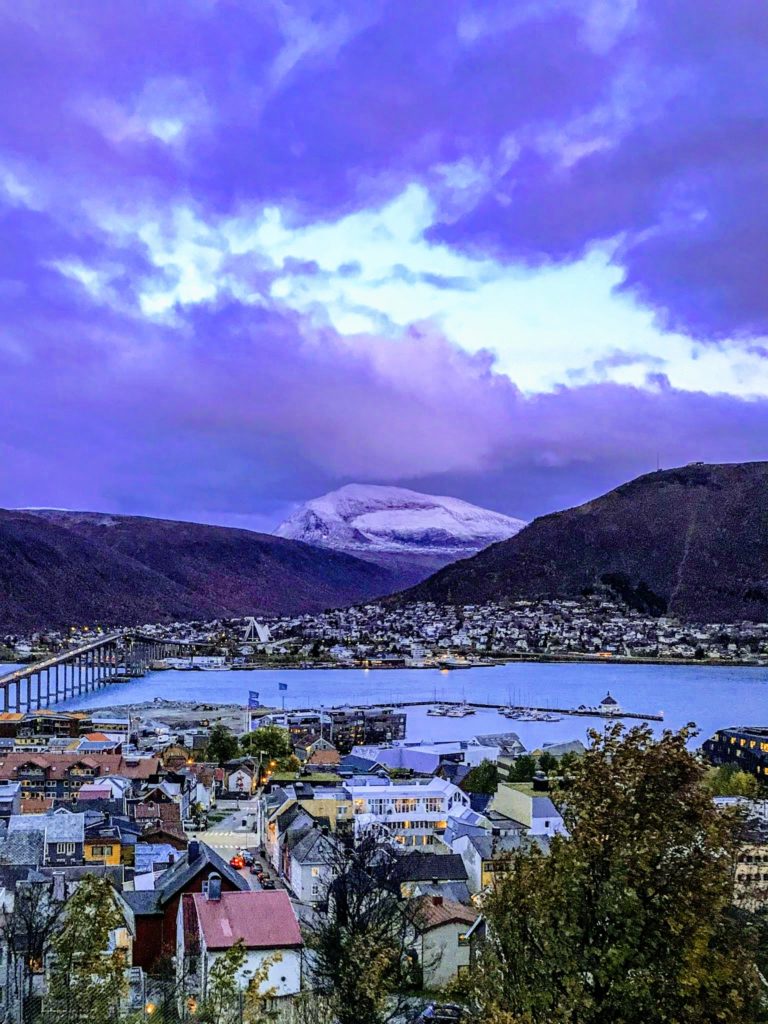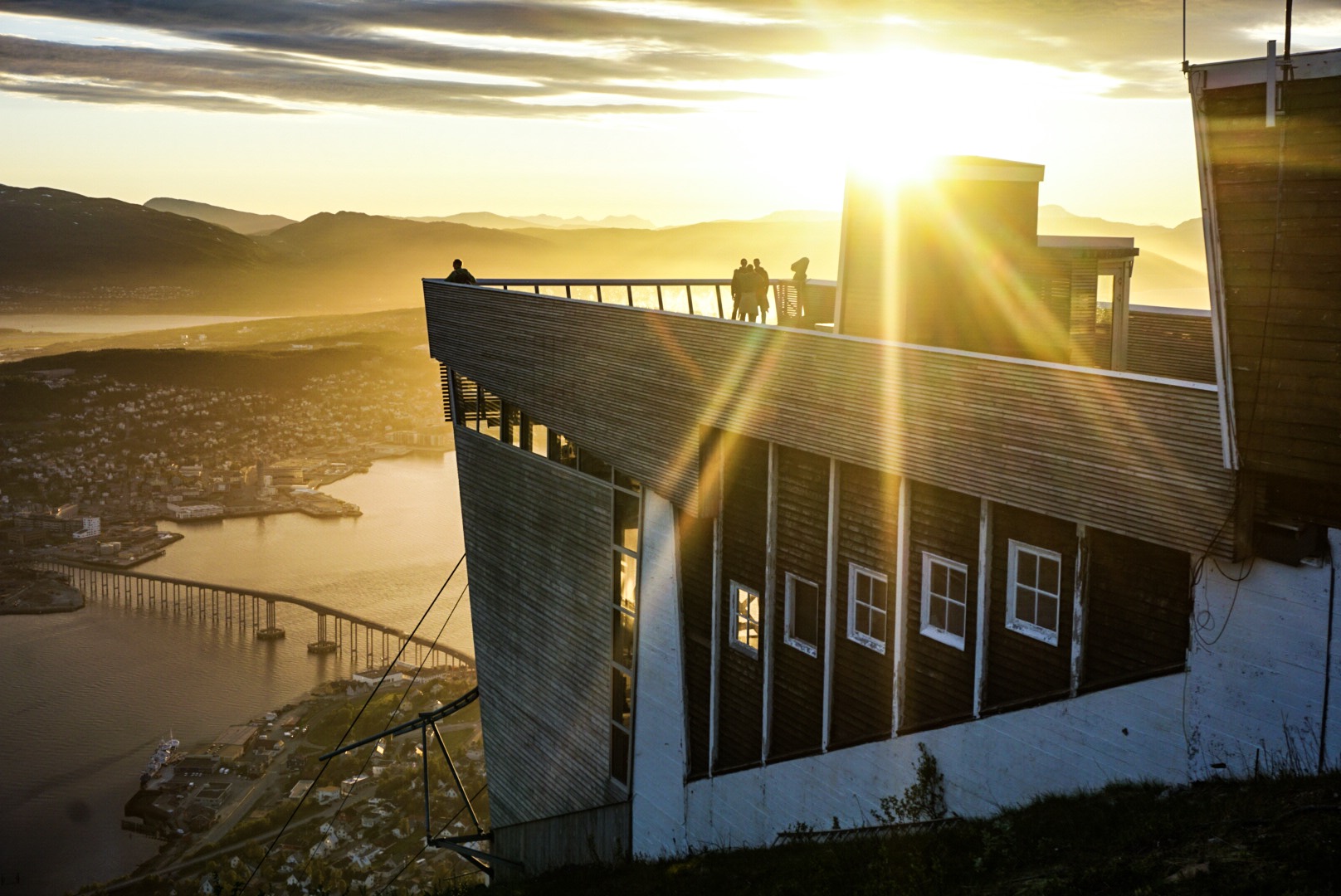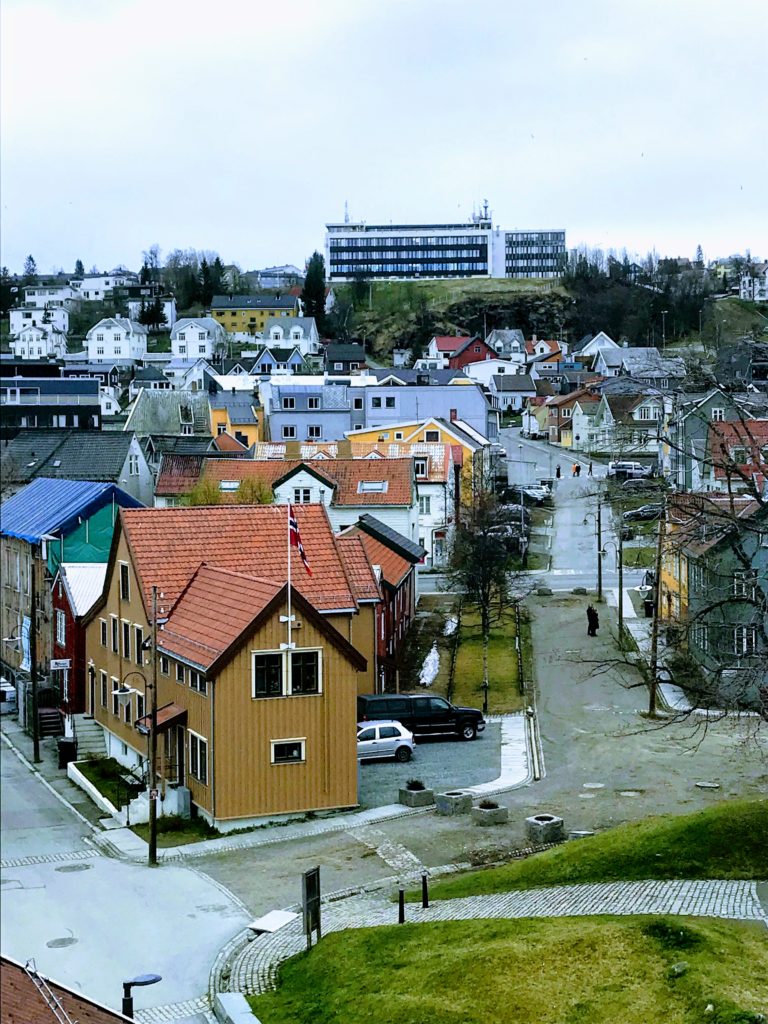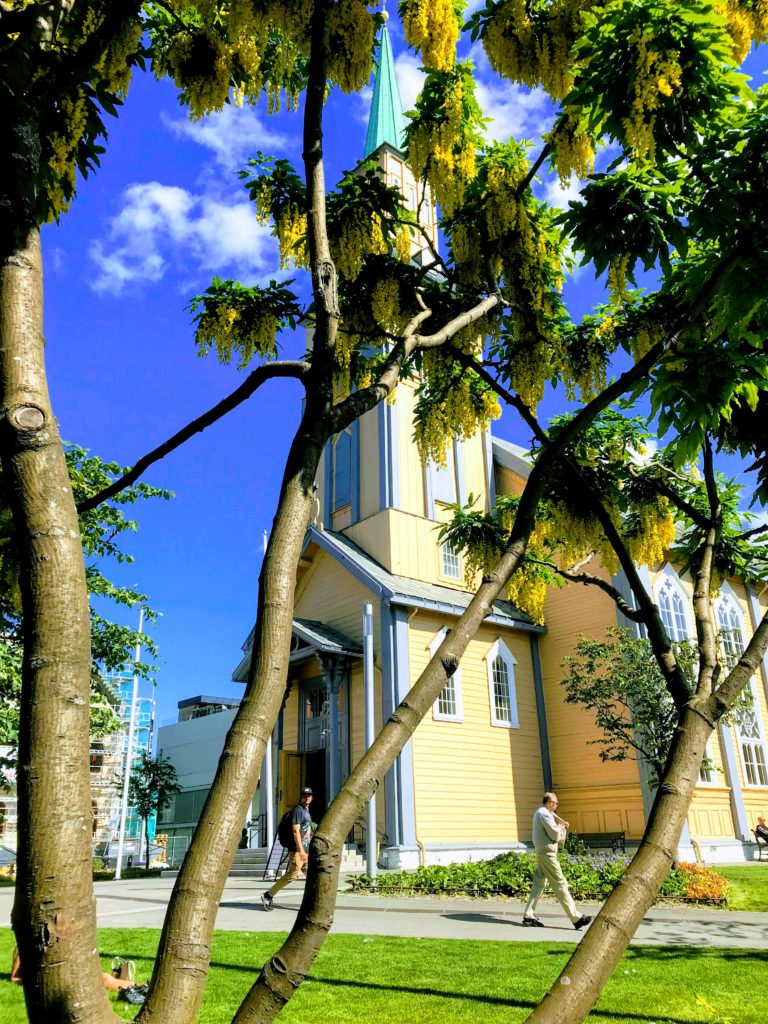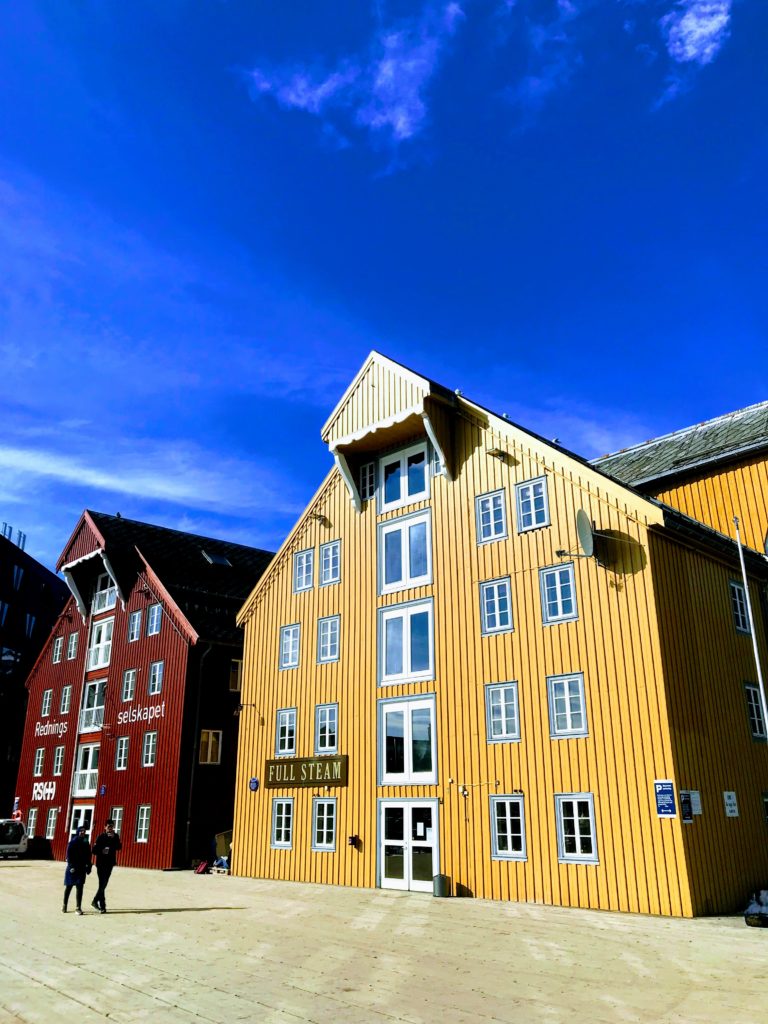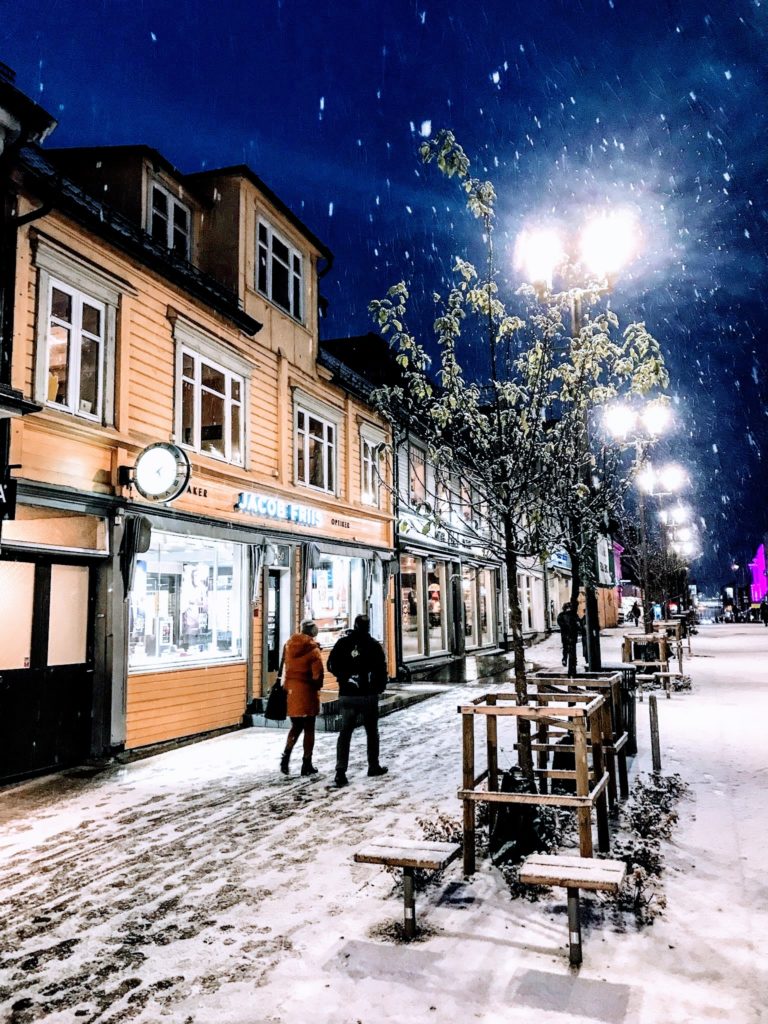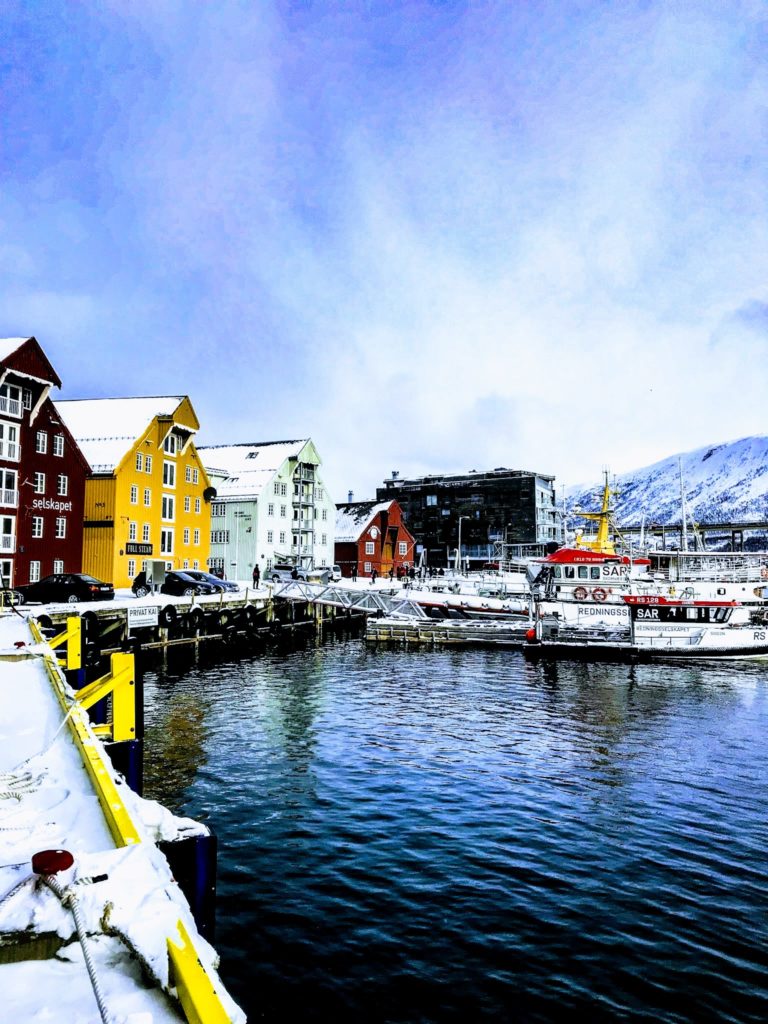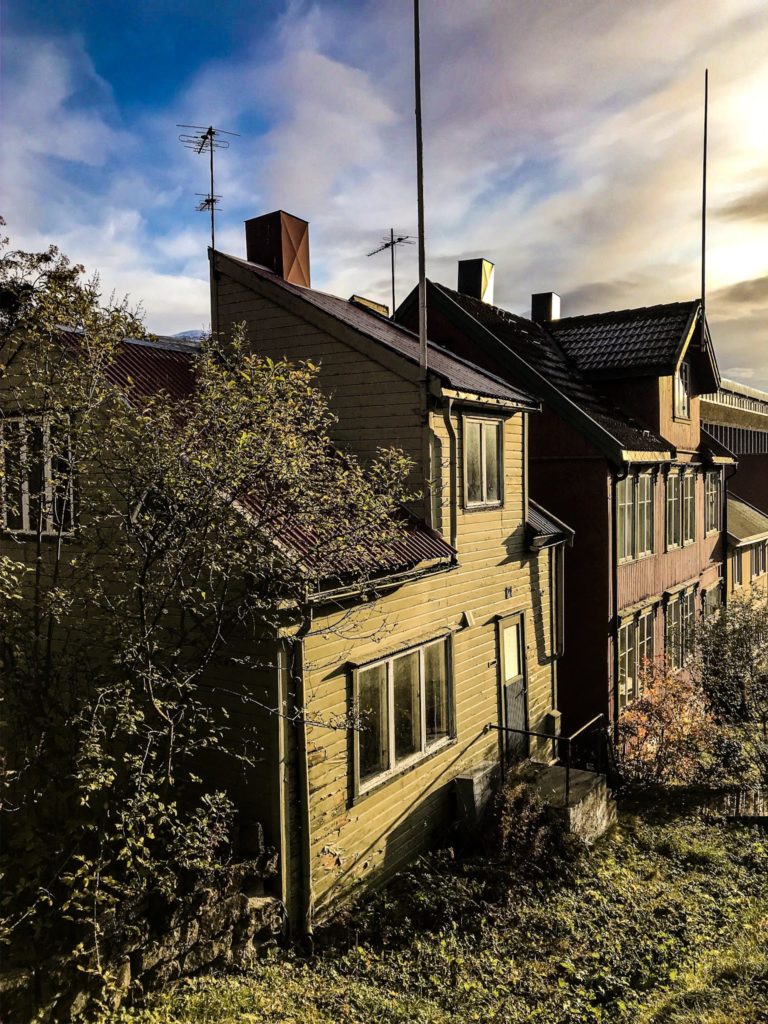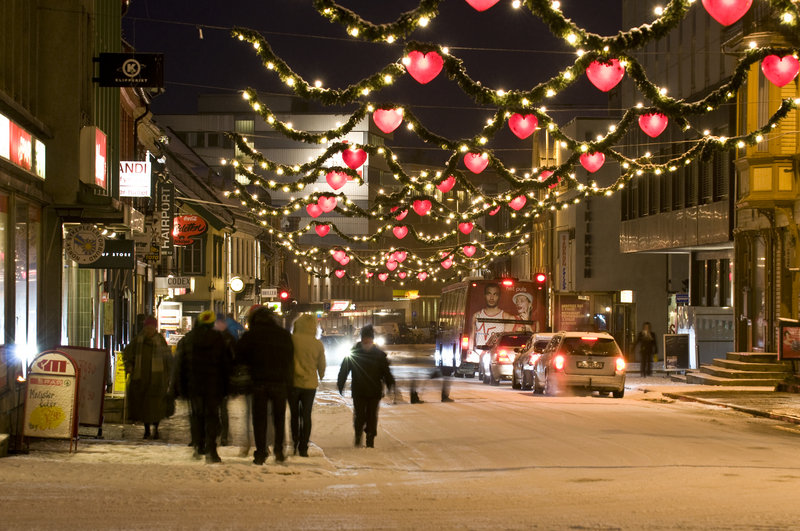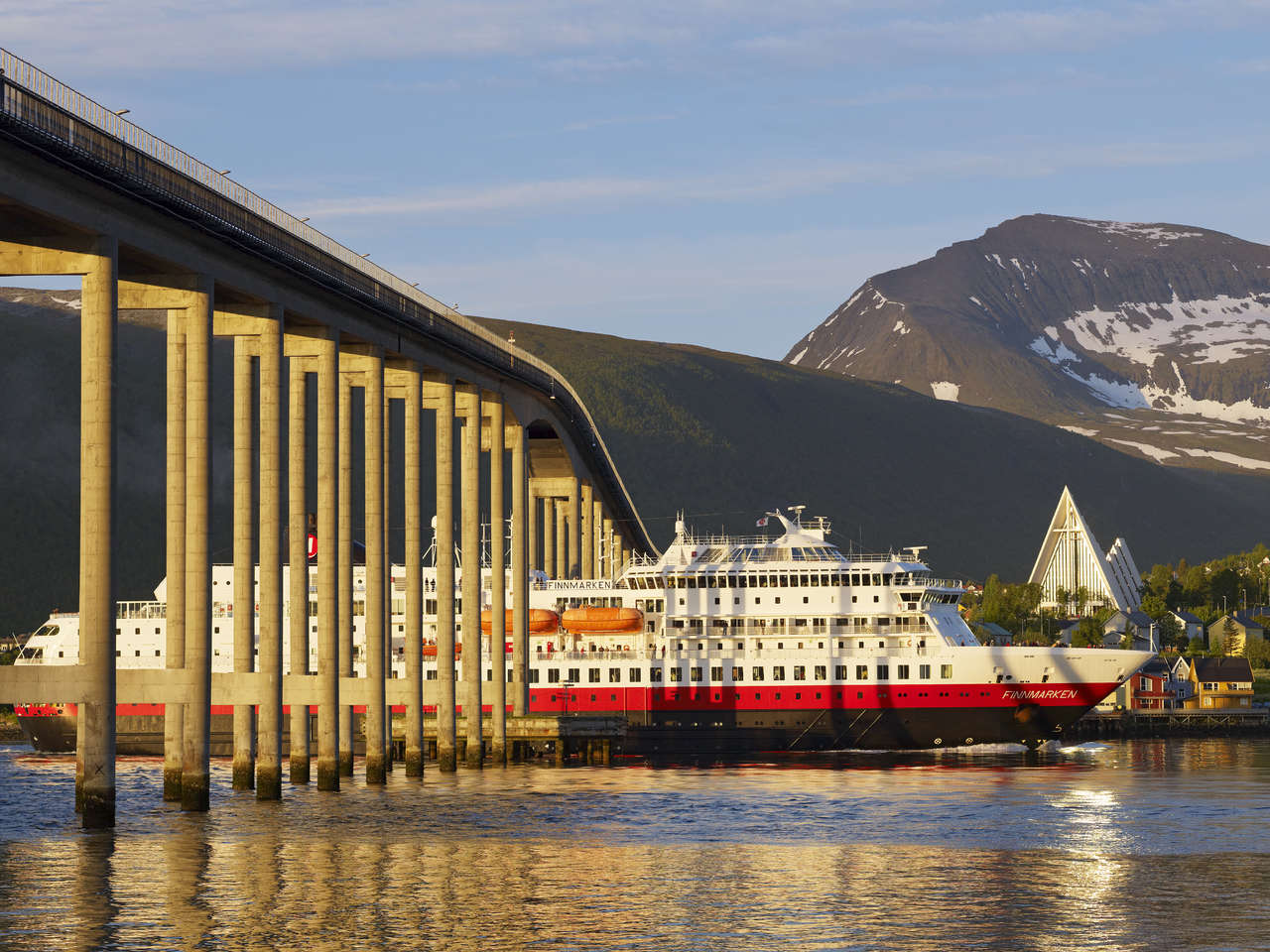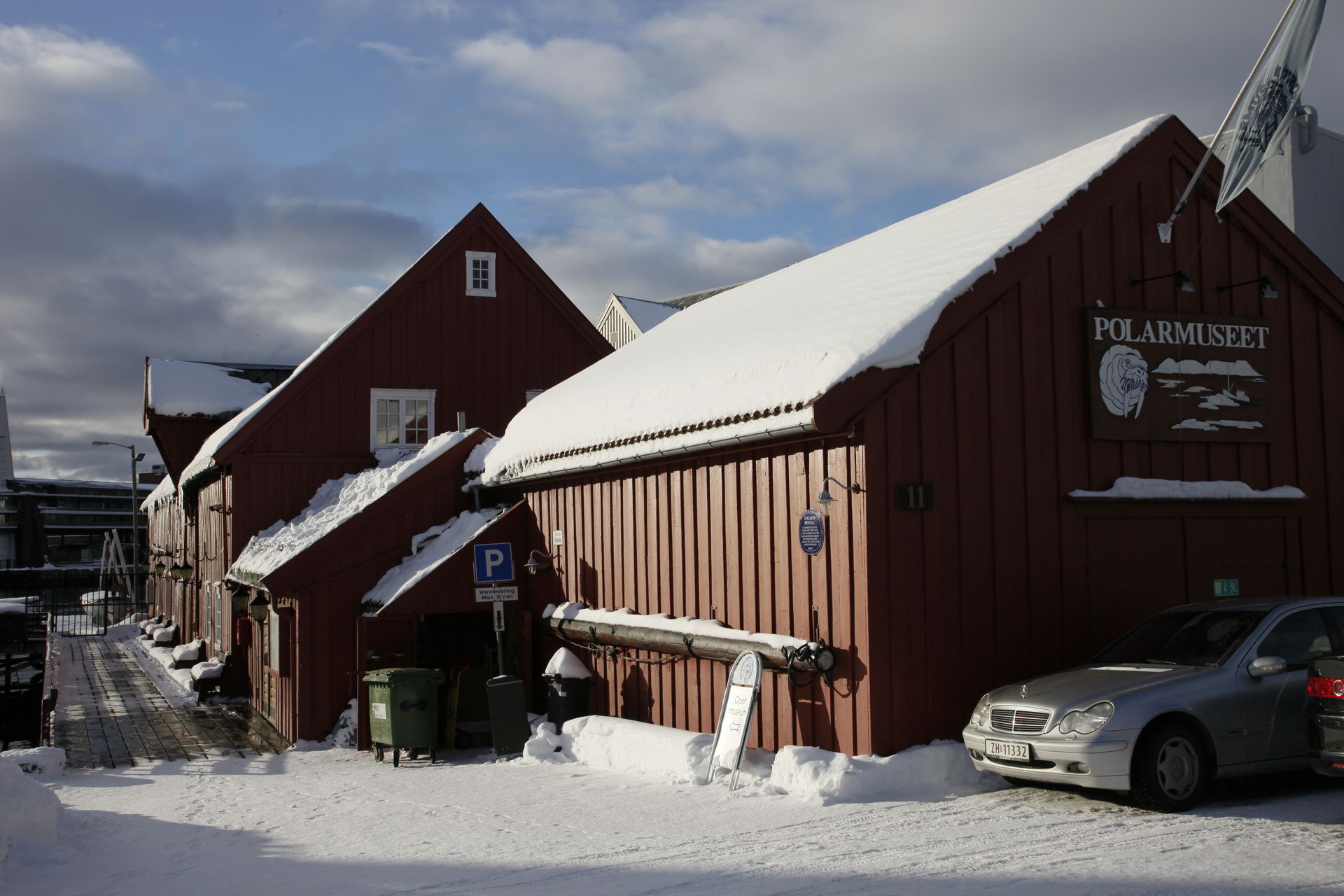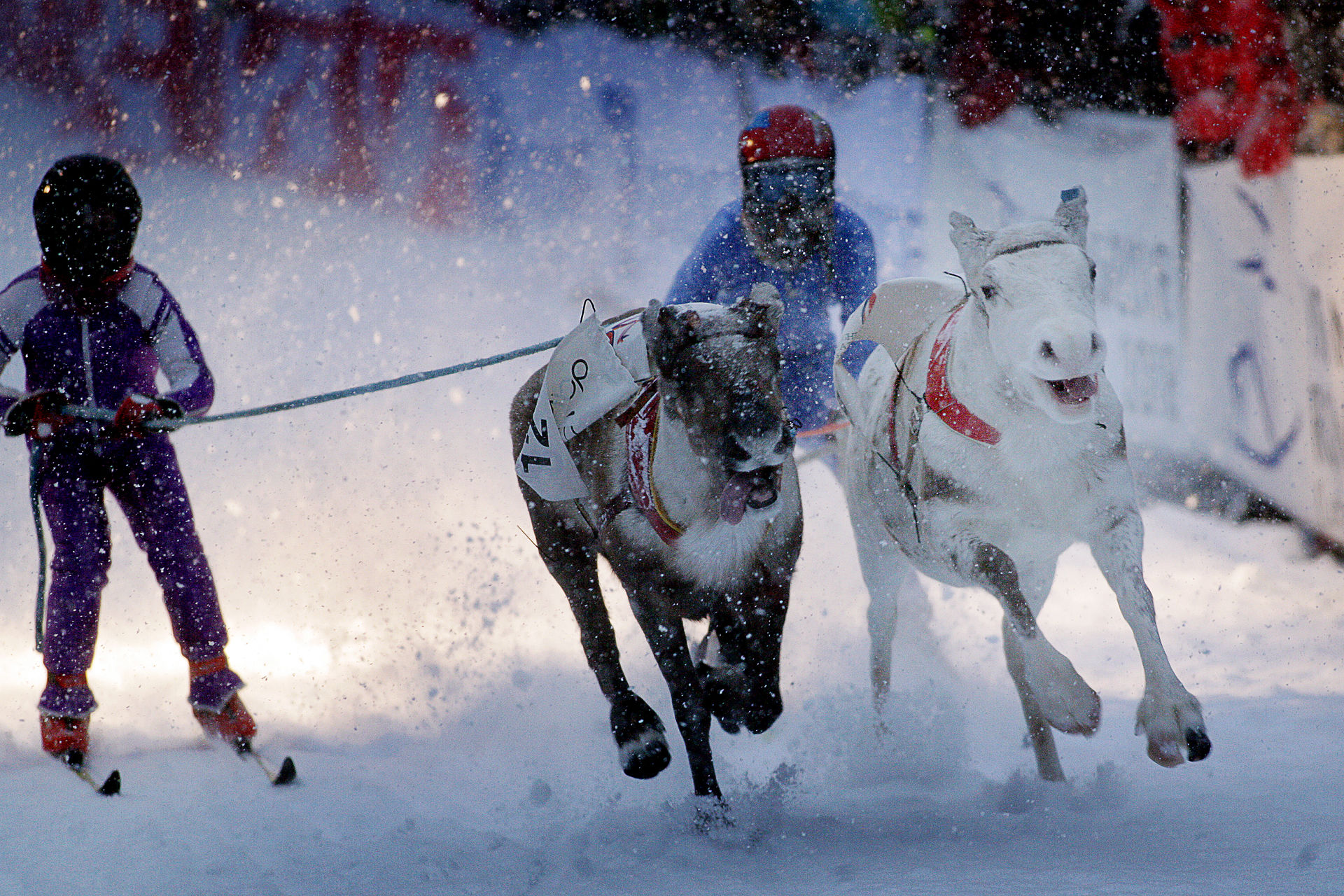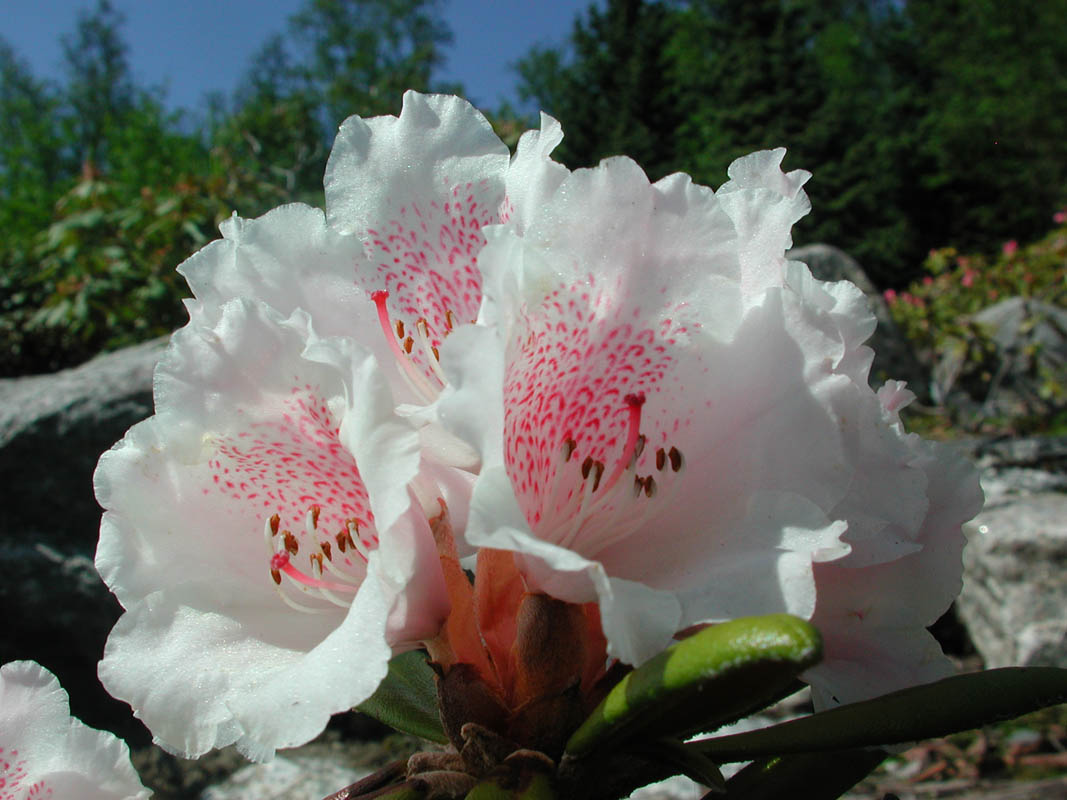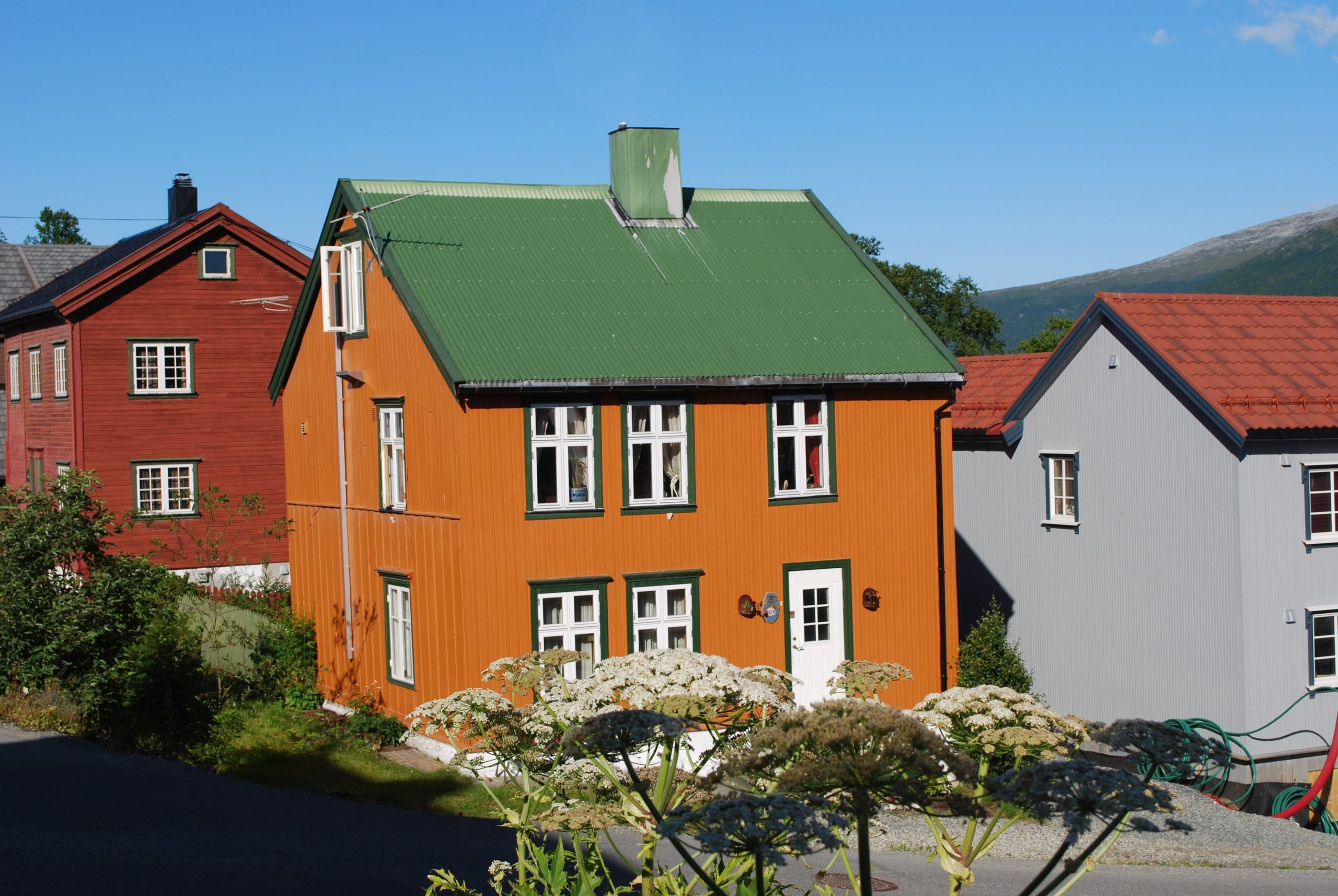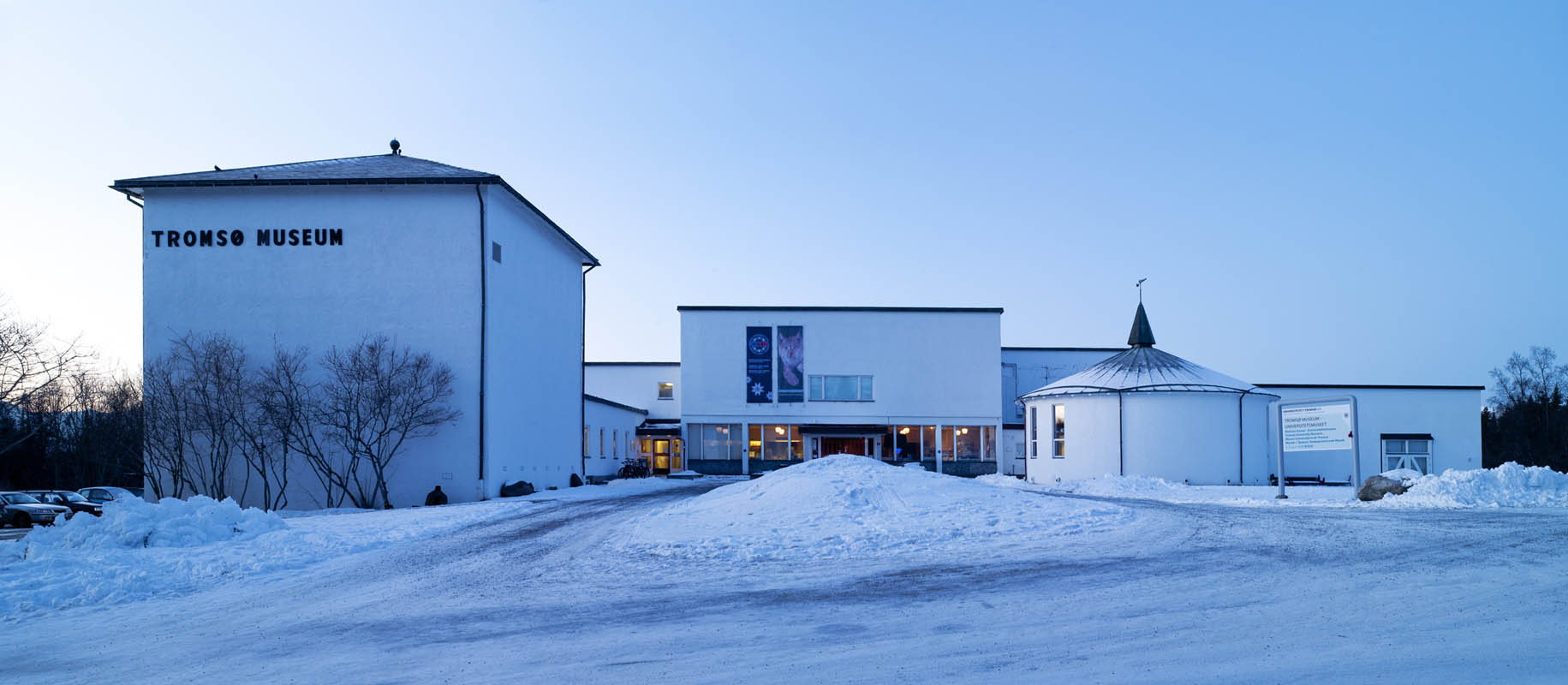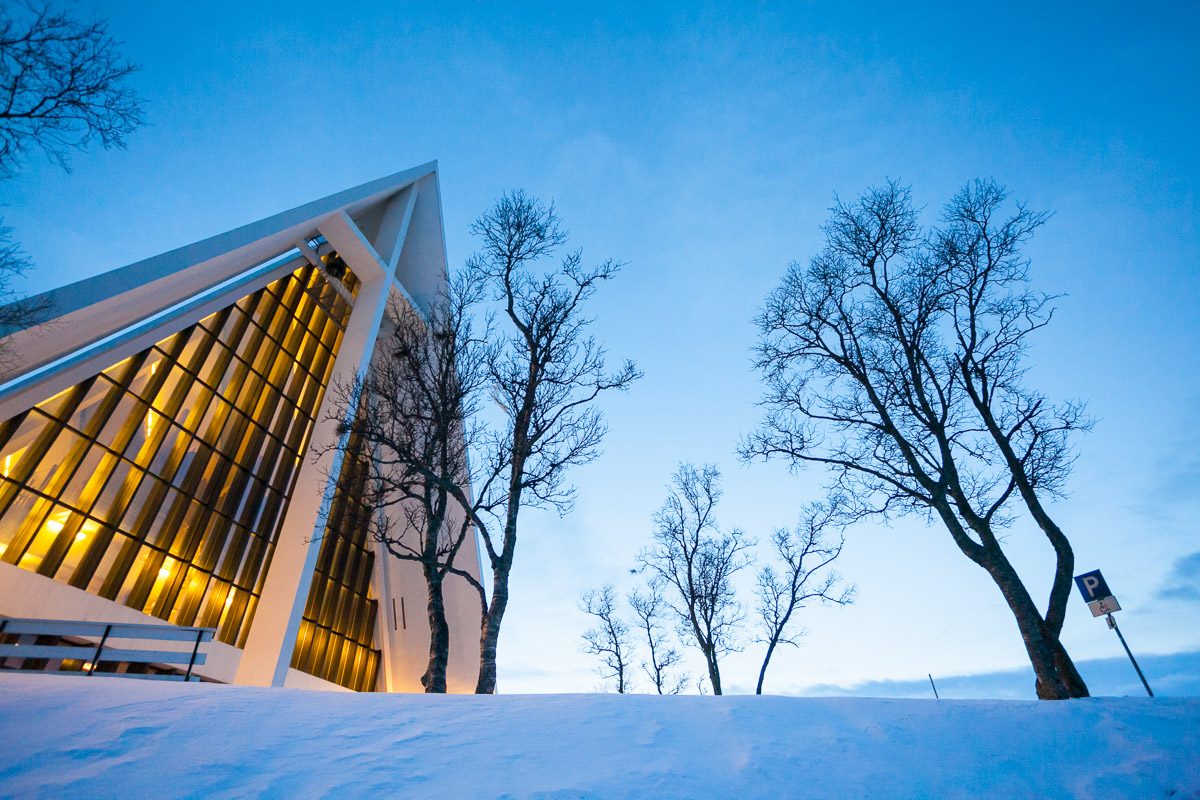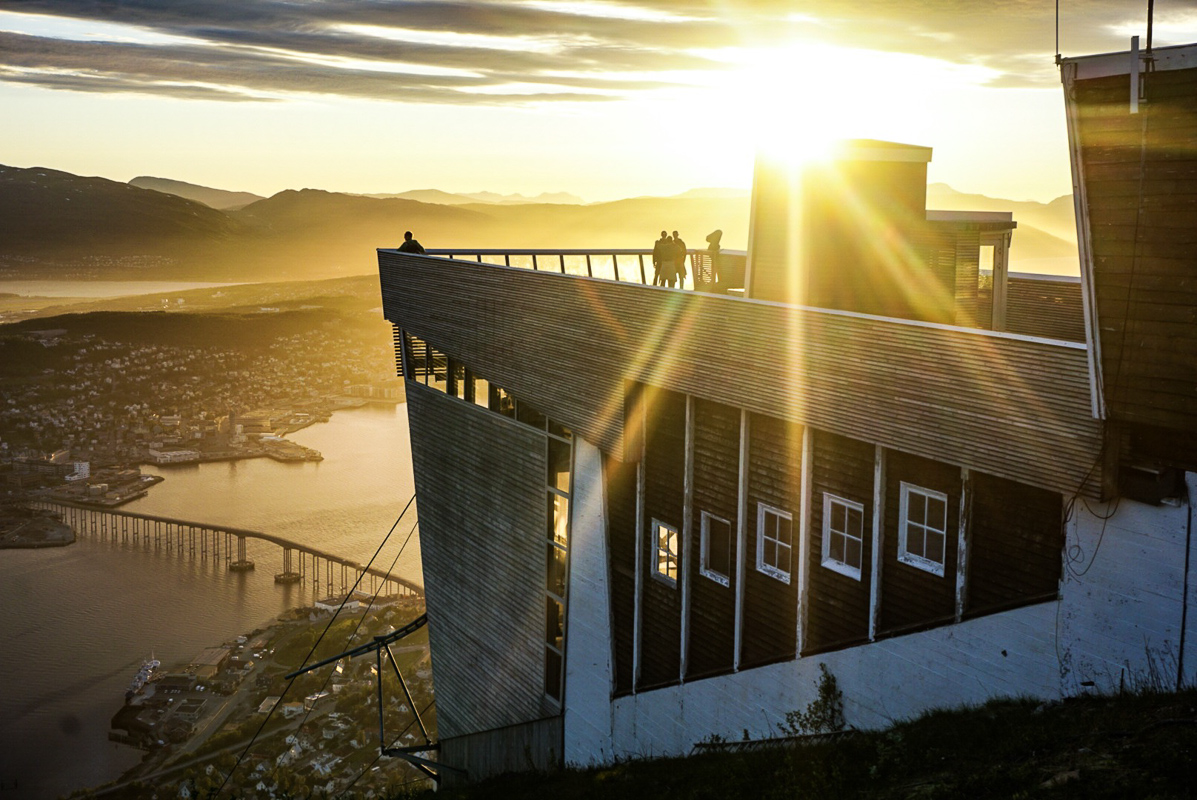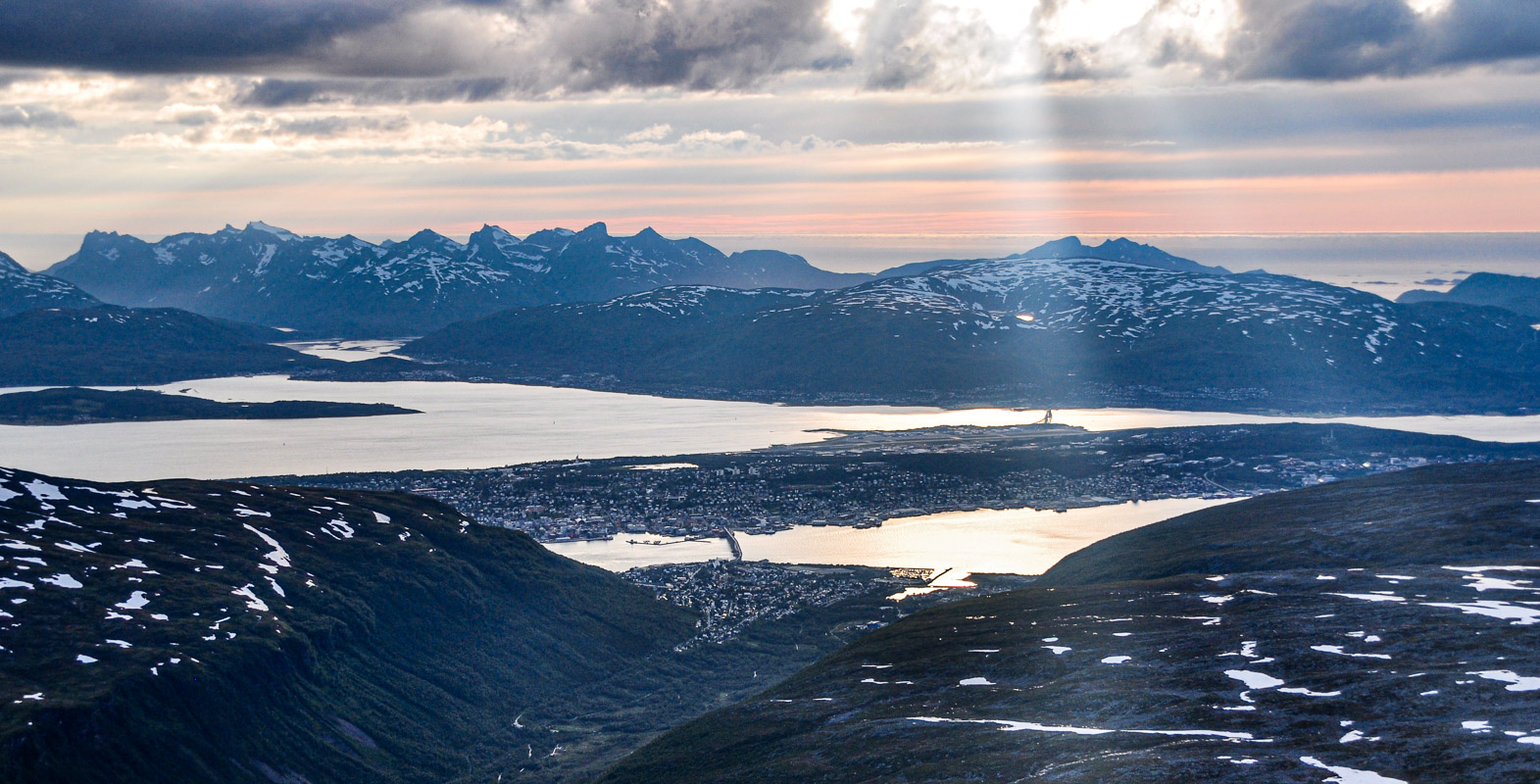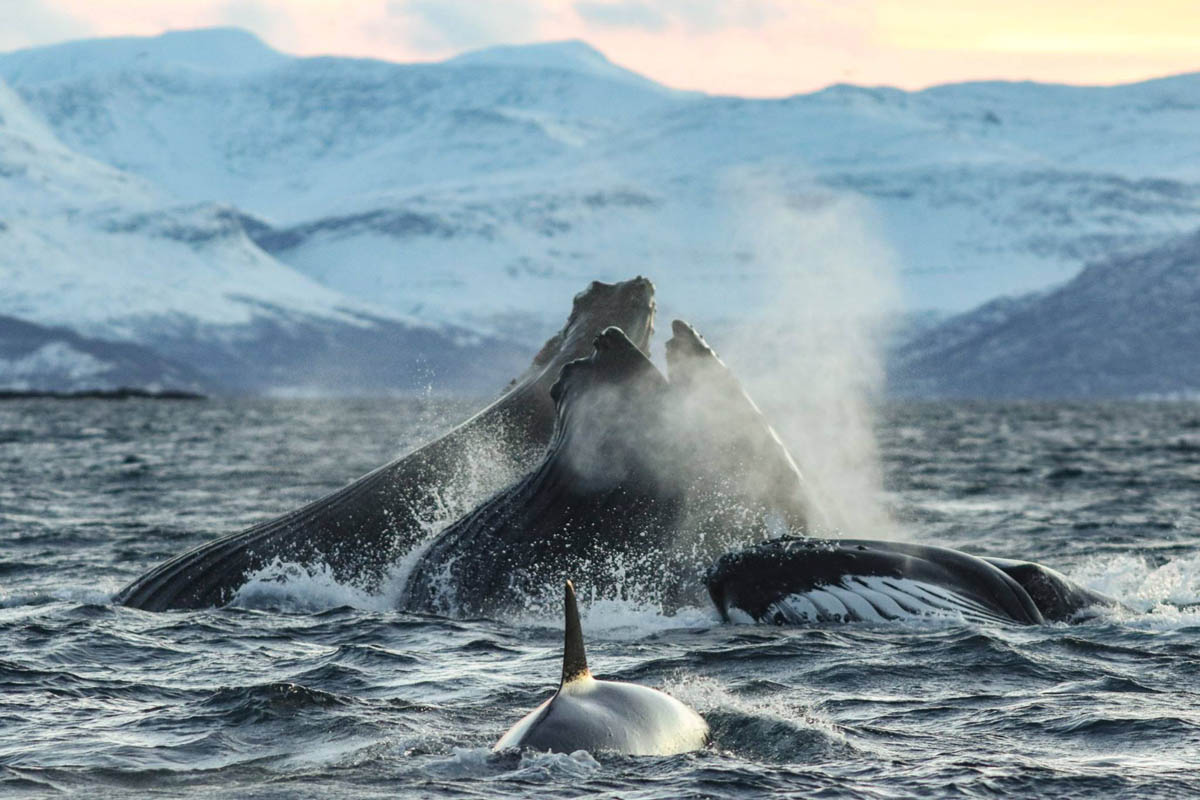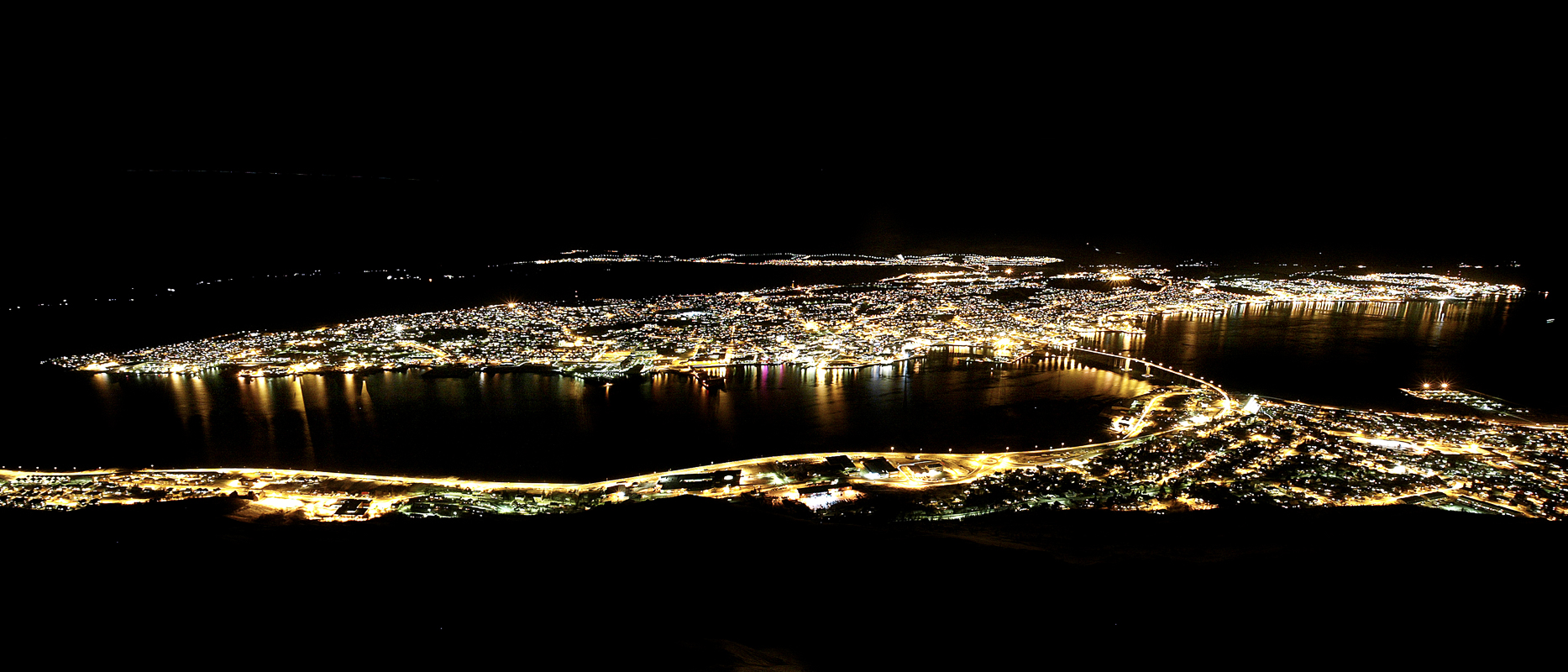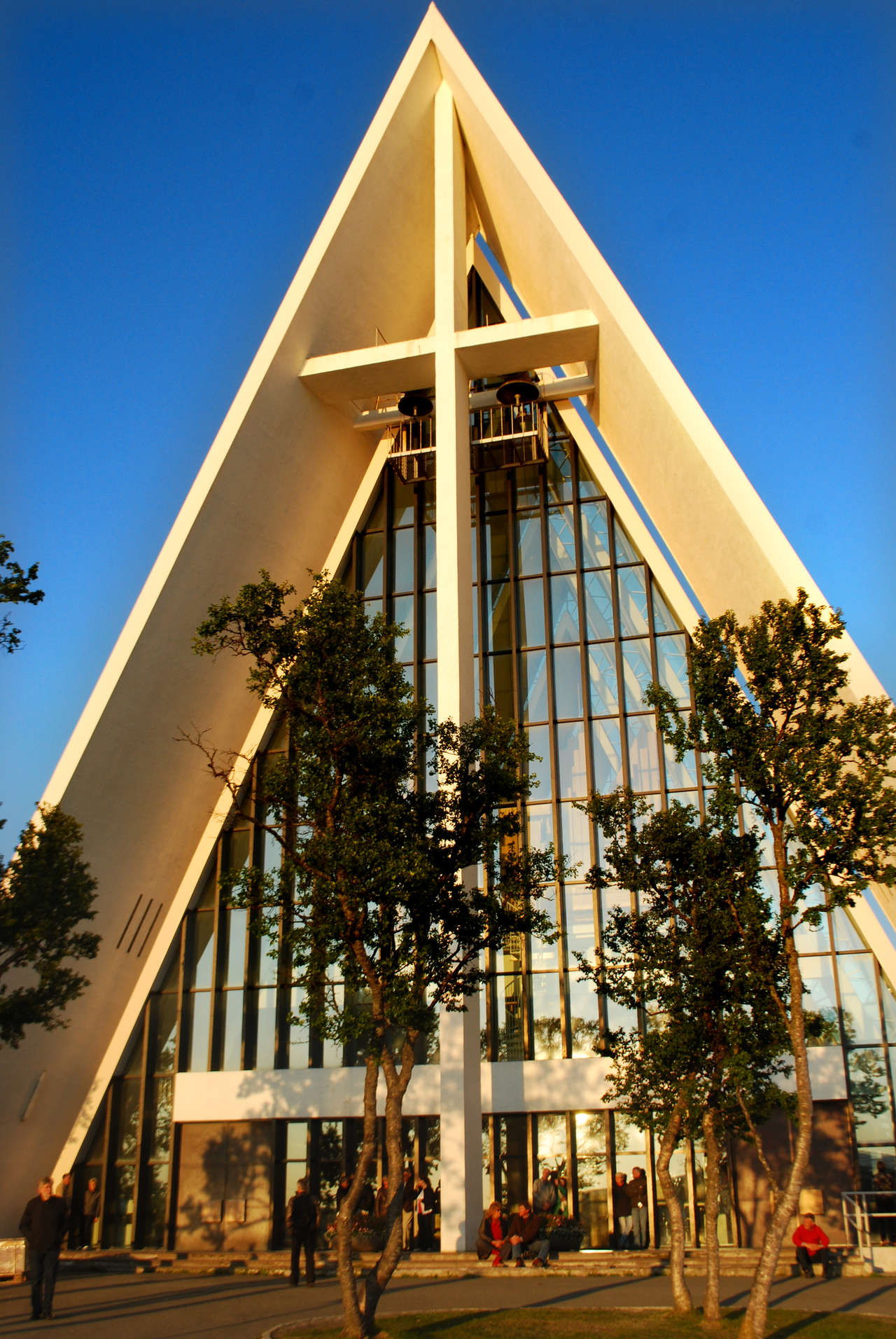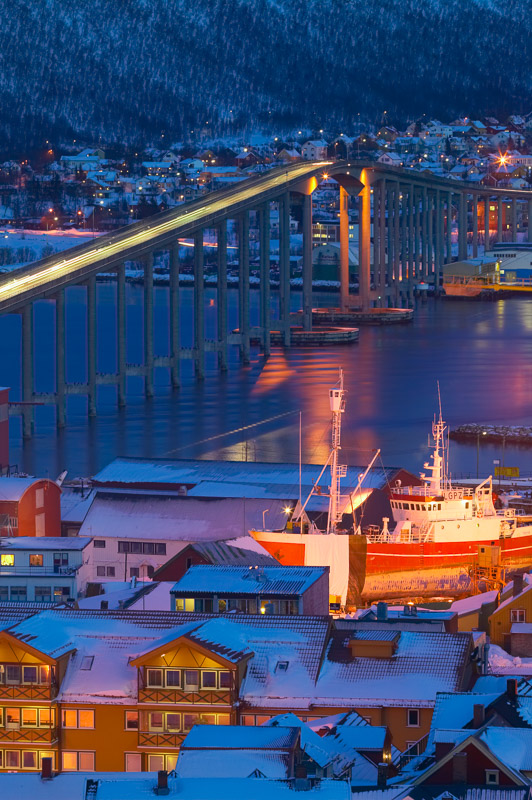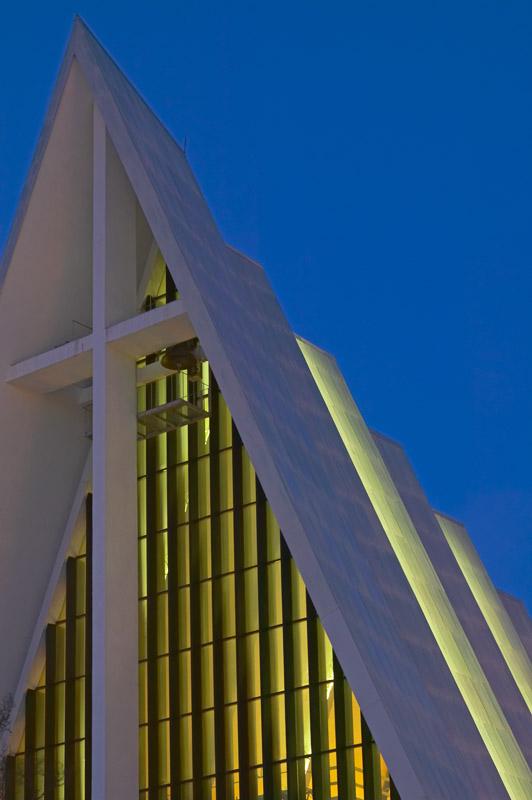Tromsø is a beautiful city between fjords, islands and mountains, with a visible past, a fascinating history, a lively, colourful city centre, an inclusive nightlife and numerous attractions. Use the city as a base to foray into Arctic wilderness chasing Midnight Sun and Northern Lights.
A real city in the middle of Arctic wilderness
Take the Tromsø cable car up to Mount Storsteinen and get the full overview of Tromsø: Waterways in every direction, peaks popping up wherever you look. And amid all this wilderness a green, forested island filled with houses, activity, and bustling life. Tromsø is the biggest city in the north, but the Arctic wilderness is evident wherever you look. Add an interesting Arctic history, a city centre more charming than beautiful, a location directly under the Northern Lights, 68 days of Midnight Sun, and you have plenty to explore.
Tromsø was start-up point for many expeditions
In the 19th c. up to after WWII, Arctic hunting was one of the city’s economic pillars. In a wide area from Newfoundland over Greenland and Svalbard to northern Russia, boats from Tromsø hunted seals, walrus, and polar bears. This made Tromsø the best source of information for scientists and explorers of yet unchartered territory in the high Arctic. Fridtjof Nansen, Roald Amundsen, and Umberto Nobile were household names in town, and many crew members were recruited here. Today, you can charter the traces of this eventful history at the Polar Museum, and in the numerous memorials around town, and maybe have a beer at the oldest waterhole in town, Ølhallen, where hunters used to tell not at all exaggerated stories.
How can a small city far north be called The Paris of the North?
Early visitors to Tromsø were stunned at the level of sophistication of the Tromsø gentry. They were greeted in not too accented French, German and English, the educated conversation revealed knowledge about what was going on in the rest of the world and the ladies were dressed in the (second) latest fashion. Maybe the visitors also had low expectations after having consulted the latitude on the map. In 1904, the German visitor G. Hartung named the city “The Paris of the North”, impressed as he was.
The city centre of Tromsø is a mixed bag
Town planning has never been a strong point in Tromsø. The city centre is a hotchpotch of old and new, sometimes blending harmoniously, other times in stark conflict. This makes the centre a photographer’s delight. Walk along the docks and look across the sound along the pillars of the Tromsø Bridge to the Arctic Cathedral on the other side, explore the streets where lovely 19th. C. wooden merchants’ residences, more modest working-class houses, art nouveau, concrete brutality, and some elegant modern shapes mix. Despite the ravages of the 60ies and 70ies, Tromsø remains one of Norway’s major historic wooden cities.
Storgata is Tromsø’s main drag
Tromsøites spend years of their lives in the Storgata, the main street. To fintrø means to walk slowly down the street to meet friends for a chat or look at people. On sunny days in spring and summer, al fresco cafes are packed with people. Online shopping has closed down some of the shops along the street. Instead a varied offer of interesting restaurants, lively cafes and wet night spots have taken over, catering to locals and tourists alike. When visiting Tromsø, you are expected to spend time in this street.
In Tromsø you should eat fish. Or goat.
In the 70ies, fish found its way to the restaurant tables of Tromsø. The term “ufesk” (“unfish”) was coined, fish like wolffish and monkfish that look really ugly, but taste fantastic. All of a sudden, a t-bone steak didn’t do it, it had to be new and inventive. Since then, fish has become a reason to travel to Tromsø for the foodie set. Sophisticated, modern fish restaurants experiment with how to prepare according to the latest trends and with spices from far away. Other eateries honour grandma’s cooking by serving traditional recipes. Carnivores should go for goat or lamb if looking for local fare.
Learn about the high north
Tromsø’s university was founded in 1972, to bring knowledge to the backward north. Instead, the university soon lost itself in the exploration of the fascinating north; the multi-cultured heritage and numerous languages, the richest sea in the world, the popular health in Arctic climes, the mysteries of the Northern Lights and many other aspects of this interesting corner of the world. For a taste of all this, head to the Tromsø University Museum to learn about the Sami people, the Northern Lights and a very valuable collection of religious art. Polaria is a more tactile place, with live seals, king crabs and interactive exhibits on the wonders of Arctic nature. The Arctic-Alpine Botanic garden has plants from every continent, most of them don’t seen in botanical gardens on lower latitudes. The Northern Norwegian Science Centre explains about the Northern Lights and the wonders of Northern Norwegian nature.
Tromsøites know the art of living
The Northern Norwegian Art Museum (Nordnorsk Kunstmuseum), several art galleries, a professional theatre, and a symphonic orchestra shared with Bodø; art and culture are an integral part of Arctic life. Festivals litter the Tromsø calendar: The Tromsø International Film Festival (TIFF) in the depth of winter, then the classical music Northern Lights Festival, followed by the Sami week. In summer, the Bukta rock festival attracts a large crowd on the city beach. Insomnia in October caters for the electronica fans. Things also take place outdoors, like the Polar Night Half Marathon in January, the Reindeer sledding championship in February, and the Midnight Sun Marathon in June/July.
Chasing the Northern Lights from Tromsø
The Northern Lights were more of a local secret until well after 2000. But the advent of digital cameras and social medias to share all the photos in, created a Northern Lights craze out there. Today, Tromsø has a mature tourist industry specialising in finding the Northern Lights. The amount of organised tours by bus, minibus, boat, snowmobile and dogsledding heading out every night to hunt for those green rays is impressive. The competition is fierce, so everybody is on their tiptoes to make sure that the lights are found.
How do you find the Northern Lights in Tromsø?
When cold inland winds blow, the sky is clear over Tromsø, and you can see the Northern Lights even from the main street. It is, however, better to find a somewhat darker location out of the centre. But when the snow showers come in from the north, keeping the city’s snow plows going day and night, there will be no Northern Lights. Instead, you should seek out a location in the rain shadow behind the Lyngen Alps, or maybe go out to the furthest islands in the Atlantic. This is where a Northern Lights guide comes in handy; used to shifting weather patterns, they can find clear skies even on hopeless days.
Tromsø has the Midnight Sun for more than two months
At 350 km north of the Arctic circle, Tromsø enjoys the rays of the Midnight Sun for 68 days. This means a good two months of absolutely no darkness. Tromsøites do their very best to stock up on vitamin D ahead of the winter, and have late barbecues at the beach on the southern tip of the island, go fishing in the ocean current at Rystraumen or climb a mountain. There is also a number of fishing trips, boat trips and organised hikes. The ultimate recommendation, though, is to listen to the Midnight Sun Concert in the Arctic Cathedral, then go up with the cable car and see the sun at its lowest point about a quarter to one.
Go hiking just outside the city, or further afield
Tromsø is surrounded by mountains, and hiking to mountain tops is one of the favourite pastimes for Tromsøites. The Sherpa steps up to the Cable Car mountain provides instant views. The city mountain of Tromsdalstinden takes all day..or maybe all night, but is all the more rewarding. The big island of Kvaløya, protecting the city against the rage of the Atlantic, offers peaks of all sizes, from easy one hour hikes to nervewreckingly precipitous climbs, notably to the ocean-facing Mount Skamtind.
Exploring the winter landscapes is fun
With snow on the ground for half the year, Tromsøites don’t sulk indoors. Instead they dress warmly and go out. There are cross country trails crisscrossing the built-up areas, and experienced cross-country skiers can also use prepared trails in the mountains. If you are unfamiliar with skis, snowshoes are a good alternative. Dog sledding is fun and can be organised as a short trip or an overnight mini-expedition. And everything between. Snowmobiling takes place in remote inland areas. A more sedate activity is ice fishing on a frozen lake. The reindeer in Tromsø’s coat of arms is there for a reason, because in Tromsø you can ride a reindeer sleigh and sit in a Sami tent and try out some reindeer meat and the strong Sami coffee brewed over the open fire.
Ski touring in the Lyngen Alps and on Kvaløya Island
Ski touring in Northern Norway started in the Lyngen Alps, and these impressive mountains keep attracting international skiers. However, this sport is expanding rapidly, and the big islands north and west of Tromsø are also seeing more skiers these days. The locals go out with headlamps in the Polar Night, but the season really takes off in late February, when the days are long enough. Then you can ski well into the Midnight Sun period in late May and early June.
Sommarøy is a tight-knit fishing community
On a cluster of islands, with magnificent sandy beaches and views toward the steep, mountainous coast of Senja Island, the fishing community of Sommarøy is a lovely excursion about an hour away. Locals come here for the beaches, or to climb the nearby hills for lovely views to nearly all of Tromsø’s 4-500 islands and islets. The midnight sun towards the island of Håja seen from Sommarøy is many tromsøites’ favourite view.
Go to the most impressive fjords
The Lyngen Alps rise 1800 metres up from the Ullsfjord, a little hour east of Tromsø. Impressive peaks, glaciers, turquoise glacier lakes and gushing rivers form an untouched wilderness. Organised tours go here to ski in the bright days of late winter and for glacier hikes in summer and autumn. There are also marked trails, some of them to manageable viewpoints. Finally, it is easy just to see them from the ferry as they approach.
Plan your trip to Tromsø
The period between Autumn equinox (about the 20th of September) and Spring Equinox (about the 20th of March) are excellent, although we often see them from late August to mid April. In Summer, the Midnight Sun pushes the Northern Lights away.
Tromsø is easy to visit all year, despite the northern latitude.The Midnight Sun period from late May to late July is a happy period for the Tromsøites, with hiking, sunbathing in refreshing temperatures, long hours on outdoor terraces and fishing at night.August and September, when summer turns into autumn, mountain hiking is particularly good, since all the snow is gone even at high altitude. The city returns to its usual self after the summer break.October and November see shorter days and are good for Northern Lights watching and socialising with the locals on the numerous festivals and cultural events, but snow, skiing and dogsledding can’t be promised.December and January are the Polar Night, and daylight is very limited. This is a good time to observe the Northern Lights, enjoy Christmas atmosphere and do winter activities, you’ll see that the lack of daylight doesn’t stop you from doing thingsFebruary and March have longer days, but still Northern Lights at night. You can ski, dogsled and snowmobile in the day, and spend the night chasing the Northern LightsApril and May are good for ski touring the surrounding mountains and sightseeing in white landscapes with only slight hints of spring. The weather is the best of the whole year.
Tromsø is well connected with Oslo, London, Helsinki, Frankfurt and Gdansk, and therefore easy to reach by plane. The train is sorely missing, but train enthusiasts go through Sweden to Narvik, and take the 5 hour bus from there. Hurtigruten, the legendary shipping line, calls at Tromsø every day all year.
The North Cape, Nordkapp, is reached by the small, green planes of Widerøe Airline. You can also take the bus, but then you have to stay the night in Alta (or even break the journey there). Hurtigruten sails every evening from Tromsø, and reaches Honningsvåg near the North Cape at midday.
You can take a bus from Tromsø to Bjerkvik near Narvik, and then change to a bus going Narvik-Svolvær. Taking the catamaran to Harstad is faster, though, and from there you can take a bus to Svolvær. Hurtigruten sails from Tromsø after midnight, and reaches Svolvær the next evening.
Tromsø is increasingly popular, but the hotel capacity is also being rapidly expanding.The main season runs from Christmas to late March. In this period, booking early is essential. February is especially popular.April and May, especially around the numerous long week-ends caused by national holidays, usually have lots of capacity, and one can shop around for reduced faresEarly June has conferences as well as tourism, as tends to be fullLate June, July and August surprisingly have plenty of capacity, with the exception of the Midnight Sun Marathon week-endSeptember to mid-December have conferences and business travel, but it should still be no trouble getting a room
Tromsø has a large number of mid-range and first-class hotels in the city centre. There are also simpler budget places both in the city centre and outside. Tromsø Camping is the only campsite in the built-up area. In the rural areas of Tromsø, there is a first class hotel in Sommarøy, and several holiday villages with self-catering huts and bungalows. All these are perfect bases for exploration summer and winter, provided you have a car.

Book your experience with Visit Tromsø
Want to visit Tromsø? Follow the link to discover more about the city and all the activities on offer.
